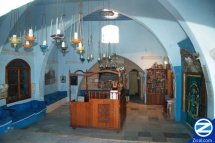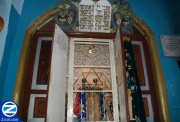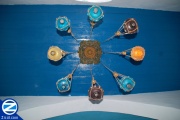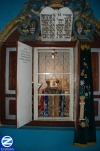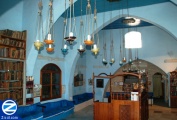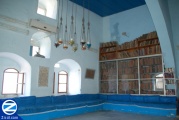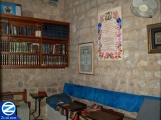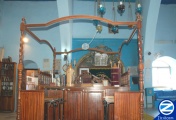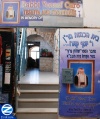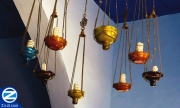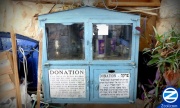Yosef Caro Synagogue Safed
The Joseph Caro Synagogue, located on Alkabetz Street in Tzfat’s Old City, is housed in the location of the former Tzfas Beit Din that was headed by Rabbi Joseph Caro. Rabbi Caro was a master of Jewish Law, authoring the Shulhan Aruch and the Beit Yosef. Some of his writing was done in a room located underneath the Karo Synagogue. Later the rabbinical court turned study hall was destroyed in the 1837 earthquake, and was rebuilt by Italian philanthropist Isaac Guetta. The Yosef Caro Shul contains several old Torah scrolls and a 'Geniza' section of ancient manuscripts. On Shabbos, the Caro Shul operates Sephardi minyanim and during the week it is open for tourists.
Contents |
[edit] Rabbi Yosef Caro
Rabbi Yosef Caro was a scion of a family that fled Spain during the Spanish Inquisition. The family settled in Turkey and it was there that Rabbi Caro developed into a renowned scholar. He was drawn to Kabbalistic teachings and in his late 40's, made his way to Safed where he established a House of Study.
Rabbi Caro compiled an extensive overview of Jewish law and practice in his book the “Beit Yosef,” an extensive overview of Halacha. The work lays out the Talmudic source of each law, its development from Biblical and Talmudic sources, the subsequent rabbinical discussions and rulings and the differing views among sages and rabbis. Rabbi Caro later summed up each section by noting the current status of each Halacha in his monumental work the 'Shulchan Aruch'.Rabbi Caro went on to head the Rabbinical Court -- the Beit Din -- in Tzfat for many years. He served as the Chief Rabbi of the nearby town of Biriya where he lived for some time. He is revered as the figure whose scholarship reunited the Jewish World in adherence to the Torah’s precepts after the turmoil of the Spanish Expulsion.
![]() Read full Zissil article on Rabbi Yosef Karo
Read full Zissil article on Rabbi Yosef Karo
[edit] Shulhan Aruch
Rabbi Caro based his next work, the “Shulhan Aruch” on the scholarship of the Beit Yosef. He intended that the Shulhan Aruch would help Jews maintain their Jewish laws and rituals in the face of the upheavals caused by the expulsions of the Inquisition. Rabbi Caro recognized that the 15th century Jewish World was scattered and in disarray. He dreamed of creating a basic guide that would provide the essential information which would allow Jews to follow the Halachot in the correct fashion as many communities emerged without rabbinic leadership.Using the Beit Yosef as his source, Rabbi Caro sat in a small room in Tsfat and synthesized the Beit Yosef into the Shulchan Aruch. The The Shulchan Aruch -- Set Table -- lays out each of Judaism’s Halachot. It reviews the sources and provides a succinct summary that guides Jews in the proper observance of each and every Jewish Law.
The Shulhan Aruch was written according to the Sepharadi traditions of Halacha. A subsequent addendum by Rabbi Moses Isserles, the “Mappah” (Tablecloth) accompanies the Shulhan Aruch with the inclusion of Ashkanazi Halachot.
![]() Read full Zissil article on the Shulchan Aruch
Read full Zissil article on the Shulchan Aruch
[edit] Yosef Caro Synagogue
The Yosef Caro Synagogue in Tzfat marks the spot where Rabbi Yosef Caro headed the Beit Din during his tenure as the “Av Beit Din of Tzfat” -- Head of the Rabbinical Court. The synagogue was destroyed in the 1837 earthquake and was rebuilt through the generosity of Isaac Guetta, an Italian Jew who funded the restoration of several Tzfat synagogues following the earthquake. Guetta imported Italian stone for the synagogue’s floor. The Caro synagogue has several old Torah scrolls which are still in use, including a 200 year-old Persian scroll, a 300 year-old Iraqi scroll and a 500 year-old scroll from Spain. The glassed-in bookshelves along the synagogue walls are the synagogue’s “Geniza”, storing sacred written works. Since the early 20th century the Ben Shimon family has served as the synagogue’s caretakers. They open the synagogue for visitors and maintain it. Currently the Karo Shul runs Minyonim on Shabbos using Nusach Edut HaMizrach / Sepharadi and is especially known for its early Kabbalas Shabbos minyan during the Summer days.[edit] More Pictures
- Yosef Caro Synagogue Photo Gallery
| |||||||||||
| ||||||||||||||


